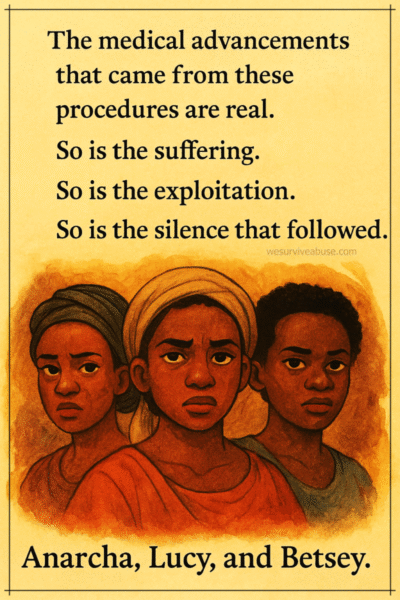The True Story Behind the Surgical Legacy Built on Black Women's Pain Between 1845 and 1849, in Montgomery, Alabama, three young enslaved Black women
The True Story Behind the Surgical Legacy Built on Black Women’s Pain
Between 1845 and 1849, in Montgomery, Alabama, three young enslaved Black women—Anarcha, Lucy, and Betsey—were subjected to brutal, repeated, and non-consensual gynecological experiments by Dr. J. Marion Sims. Today, Sims is often glorified in medical history as the “father of modern gynecology.”
But the truth is: whatever legacy he built, he built on their backs.

📍 So, what we know:
-
Estimated age: Anarcha ~17 years old
-
Year of experimentation began: 1845
-
Status: Enslaved young woman in Montgomery, Alabama
-
Number of surgeries: At least 30, without anesthesia
🕯️ What We Know About Lucy:
-
She was about 18 years old at the time of her first surgery.
-
She had recently given birth, and was suffering from vesicovaginal fistula, a common childbirth injury during that time—especially for young women without access to care.
-
Lucy was Sims’ first experimental surgery patient.
-
During the procedure:
-
No anesthesia was used.
-
She was described as being in excruciating pain, crying out throughout the surgery.
-
Historical records say she almost died from sepsis, likely due to Sims’ unsanitary tools and methods.
-
🕯️ What We Do Know:
-
Betsey was one of the first three women experimented on by Dr. J. Marion Sims between 1845 and 1849.
-
She was enslaved, which means she could not legally consent or refuse.
-
She underwent multiple surgeries without anesthesia.
-
Like Lucy and Anarcha, her pain and survival were exploited for medical advancement.
🔍 The Erasure Is Part of the Violence
Silencing. The fact that we don’t know her age, her full name, or what happened to her after—is part of the wound.
It reflects how enslaved Black women’s humanity was systemically erased: their ages, their stories, even their deaths left unmarked.
But we say her name now—Betsey—and in doing so, we restore what history tried to withhold.
🕯️ Who Was Anarcha Westcott?
Anarcha was a teenager—enslaved, exhausted, and likely recovering from a traumatic childbirth when Sims began experimenting on her. She endured at least 30 surgeries to treat a condition known as vesicovaginal fistula, a painful and stigmatizing injury resulting from obstructed labor.
These surgeries were done without anesthesia, despite the fact that ether had become available in 1846. Sims and many white physicians of that era believed in a grotesque and racist myth: that Black people, particularly Black women, didn’t feel pain the same way white people did.
💔 She Was Not a Patient. She Was Property.
Sims did not ask Anarcha for her consent. He did not treat her as a human being.
She, along with Lucy and Betsey, were enslaved women—which meant they had no right to refuse, no say in what happened to their bodies, and no protection under the law.
They were used. Over and over again.
Not for healing—but for history.
Not for their well-being—but for someone else’s glory.
And then, when Sims had perfected his technique—he began operating on white women, with anesthesia, and with accolades.
🔍 The Deeper Truth
The medical advancements that came from these procedures are real.
So is the suffering.
So is the exploitation.
So is the silence that followed.
Anarcha, Lucy, and Betsey were never compensated.
They were never acknowledged in their lifetimes.
They were not called pioneers or heroes or patients.
They were treated as disposable—even though they are foundational.
🕊️ Legacy and Reckoning
Today, Black feminist scholars, historians, and truth-tellers are reclaiming the names and stories of these women. Sims’ statues have come down. But the harm is still embedded in systems—in how medicine still treats Black women’s pain, how silence is expected, and how trauma is often overlooked.
We say their names now not with pity, but with reverence:
-
Anarcha.
-
Lucy.
-
Betsey.
Not victims.
Mothers.
Foundations.
Unacknowledged architects of knowledge.
✊🏽 Let Us Say This Clearly:
They were not just experimented on.
They were violated.
And they were never forgotten—not by us.